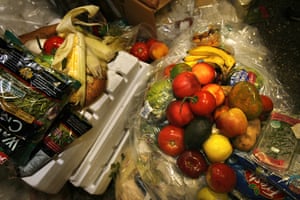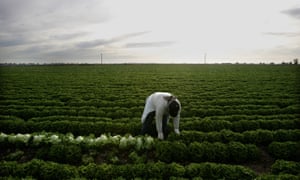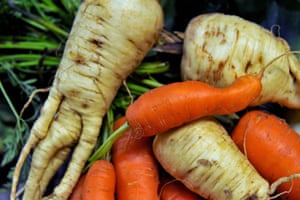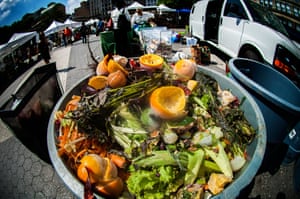Half of all US food produce is thrown away, new
research suggests
The
demand for ‘perfect’ fruit and veg means much is discarded, damaging the
climate and leaving people hungry

Discarded food is the biggest single component of US
landfill and incinerators, according to the Environmental Protection Agency.
Photograph: Alamy
Suzanne Goldenberg US environment
correspondent
Americans throw away almost as much food as
they eat because of a “cult of perfection”, deepening hunger and poverty, and
inflicting a heavy toll on the environment.
Vast quantities of fresh produce grown in the
US are left in the field to rot, fed to livestock or hauled directly from the
field to landfill, because of unrealistic and unyielding cosmetic standards,
according to official data and interviews with dozens of farmers, packers,
truckers, researchers, campaigners and government officials.
From the fields and orchards of California to
the population centres of the east coast, farmers and others on the food
distribution chain say high-value and nutritious food is being sacrificed to
retailers’ demand for unattainable perfection.
“It’s all about blemish-free produce,” says
Jay Johnson, who ships fresh fruit and vegetables from North Carolina and
central Florida. “What happens in our business today is that it is either
perfect, or it gets rejected. It is perfect to them, or they turn it down. And
then you are stuck.”
Food waste is often described as a
“farm-to-fork” problem. Produce is lost in fields, warehouses, packaging,
distribution, supermarkets, restaurants and fridges.
By one government tally, about 60m tonnes of
produce worth about $160bn (£119bn), is wasted by retailers and consumers every
year - one third of all foodstuffs.

Edible food dumped by vendors in a New York market. There
is a demand for ‘blemish-free produce’ in the industry. Photograph: LA
Times/Getty
But that is just a “downstream” measure. In
more than two dozen interviews, farmers, packers, wholesalers, truckers, food
academics and campaigners described the waste that occurs “upstream”: scarred
vegetables regularly abandoned in the field to save the expense and labour
involved in harvest. Or left to rot in a warehouse because of minor blemishes
that do not necessarily affect freshness or quality.
When added to the retail waste, it takes the
amount of food lost close to half of all produce grown, experts say.
“I would say at times there is 25% of the crop
that is just thrown away or fed to cattle,” said Wayde Kirschenman, whose
family has been growing potatoes and other vegetables near Bakersfield,
California, since the 1930s. “Sometimes it can be worse.”
“Sunburnt” or darker-hued cauliflower was
ploughed over in the field. Table grapes that did not conform to a wedge shape
were dumped. Entire crates of pre-cut orange wedges were directed to landfill.
In June, Kirschenman wound up feeding a significant share of his watermelon
crop to cows.
Food For Free staff collect items left over from Harvard
University’s graduation events in a drive to reduce waste. Photograph: Boston
Globe/Getty
Researchers acknowledge there is as yet no
clear accounting of food loss in the US, although thinktanks such as the World Resources
Institute are working towards amore accurate reckoning.
Imperfect Produce, a subscription delivery
service for “ugly” food in the San Francisco Bay area, estimates that about
one-fifth of all fruit and vegetables are consigned to the dump because they do
not conform to the industry standard of perfection.
But farmers, including Kirschenman, put the
rejection rate far higher, depending on cosmetic slights to the produce because
of growing conditions and weather.
That lost food is seen increasingly as a drag
on household incomes – about $1,600 a year for a family of four – and a direct challenge to global efforts to
fight hunger, poverty and climate change.
Globally, about one-third of food is wasted:
1.6bn tonnes of produce a year, with a value of about $1tn. If this wasted food
were stacked in 20-cubic metre skips, it would fill 80m of them, enough to
reach all the way to the moon, and encircle it once. Taking action to tackle
this is not impossible, as countries like Denmark have shown.
The Obama administration and the UN have
pledged to halve avoidable food waste by 2030. Food producers, retail chains
and campaign groups such as theNatural Resources Defense Council have
also vowed to reduce food loss in theReFED initiative.
Food experts say there is growing awareness
that governments cannot effectively fight hunger, or climate change, without
reducing food waste. Food waste accounts for about 8% of global climate
pollution, more than India or Russia.
“There are a lot of people who are hungry and
malnourished, including in the US. My guess is probably 5-10% of the population
are still hungry – they still do not have enough to eat,” said Shenggen Fan,
the director general of the International Food Policy Research Institute in
Washington. “That is why food waste, food loss matters a great deal. People are
still hungry.”
That is not counting the waste of water, land
and other resources, or the toll on the climate of producing food that ends up
in landfill.
Within the US, discarded food is the biggest
single component of landfill and incinerators, according to the Environmental
Protection Agency. Food dumps are a rising source of methane, a far more
powerful greenhouse gas than carbon dioxide. But experts readily acknowledge
that they are only beginning to come to grips with the scale of the problem
.

A farm worker harvests lettuce in a field near Calexico,
California. The US has set a target of halving avoidable food waste.
Photograph: AFP/Getty
The May harvest season in Florida found
Johnson with 11,000kg (24,250lbs) of freshly harvested spaghetti squash in his
cool box – perfect except for brown scoring on the rind from high winds during
a spring storm.
“I’ve been offering it for six cents a pound
for a week and nobody has pulled the trigger,” he said. And he was “expecting
an additional 250,000lbs of squash,” similarly marked, in his warehouse a
fortnight later.
“There is a lot of hunger and starvation in
the United States, so how come I haven’t been able to find a home for this
six-cents-a-pound food yet?” Johnson asked.
Such frustrations occur regularly along the
entirety of the US food production chain – and producers and distributors
maintain that the standards are always shifting. Bountiful harvests bring more
exacting standards of perfection. Times of shortage may prove more forgiving.
Retail giants argue that they are operating in
consumers’ best interests, according to food experts. “A lot of the waste is
happening further up the food chain and often on behalf of consumers, based on
the perception of what those consumers want,” said Roni Neff, the director of
the food system environmental sustainability and public health programme at the Johns Hopkins Center for a Livable Future in
Baltimore.
“Fruit and vegetables are often culled out
because they think nobody would buy them,” she said.

Scarred and oddly shaped vegetables are regularly
abandoned in the field to save the expense and labour involved in harvest.
Photograph: AFP/Getty
But Roger Gordon, who founded the Food Cowboy startup
to rescue and re-route rejected produce, believes that the waste is built into
the economics of food production. Fresh produce accounts for 15% of supermarket
profits, he argued.
“If you and I reduced fresh produce waste by
50% like [the US agriculture secretary] Vilsack wants us to do, then
supermarkets would go from [a] 1.5% profit margin to 0.7%,” he said. “And if we
were to lose 50% of consumer waste, then we would lose about $250bn in economic
activity that would go away.”
Some supermarket chains and industry groups in
the US are pioneering ugly produce sections and actively campaigning to reduce
such losses. But a number of producers and distributors claimed that some
retailing giants were still using their power to reject produce on the basis of
some ideal of perfection, and sometimes because of market conditions.
The farmers and truckers interviewed said they
had seen their produce rejected on flimsy grounds, but decided against
challenging the ruling with the US department of agriculture’s dispute
mechanism for fear of being boycotted by powerful supermarket giants. They also
asked that their names not be used.

Compost collection at Union Square Greenmarket in New
York. Photograph: Alamy
“I can tell you for a fact that I have
delivered products to supermarkets that was [sic] absolutely gorgeous and
because their sales were slow, the last two days they didn’t take my product
and they sent it back to me,” said the owner of a mid-size east coast trucking
company.
“They will dig through 50 cases to find one
bad head of lettuce and say: ‘I am not taking your lettuce when that lettuce
would pass a USDA inspection.’ But as the farmer told you, there is nothing you
can do, because if you use the Paca [Perishable Agricultural Commodities Act of
1930] on them, they are never going to buy from you again. Are you going to
jeopardise $5m in sales over an $8,000 load?”
He said he experienced such rejections, known
in the industry as kickbacks, “a couple of times a month,” which he considered
on the low side for the industry. But he said he was usually able to sell the
produce to another buyer.

Squash left to rot in a field in Florida. Globally, about
one-third of food is wasted: a total of 1.6bn tonnes a year. Photograph: Alamy
The power of the retail chains creates fear
along the supply chain, from the family farmer to the major producer.
“These big growers do not want to piss off
retailers. They don’t enforce Paca on Safeway, Walmart or Costco,” said Ron
Clark, who spent more than 20 years working with farmers and food banks before
co-founding Imperfect Produce.
“They are just not going to call because that
will be the last order they will ever sell to them. That’s their fear. They are
really in a pickle.”

No comments:
Post a Comment